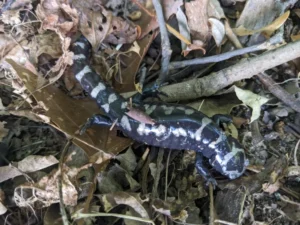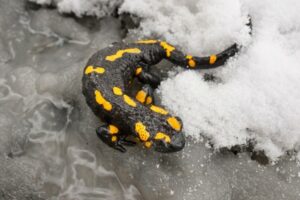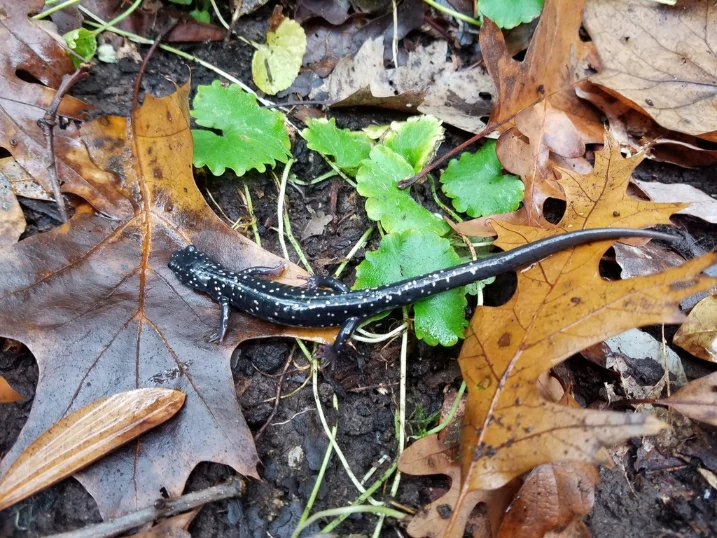Salamanders are quiet, secretive amphibians that often hide under logs, rocks, or leaf litter. Their slim bodies and smooth, wet skin make them look gentle, but many people wonder how fast they can move. Are salamanders quick or slow?
Most salamanders move slowly, but they can sprint in short bursts when scared or threatened. Studies have found that fire salamanders can run in short bursts between 0.1 and 0.8 kilometers per hour.
They usually stay still and quiet instead of running fast. But when danger comes, they can dash away with surprising speed for a little bit.
Why Salamanders Are Not Built for Speed
Salamanders aren’t known for being fast. Most of the time, they move slowly and carefully.
Their bodies are long and low to the ground. They have short legs and soft feet. Instead of jumping or sprinting like frogs, salamanders usually walk or crawl.

Their legs work better for sneaking through wet leaves or squeezing into tight spots than for running fast.
They also have delicate skin that needs to stay moist.
Moving fast for too long could dry them out. Staying still and hidden helps keep their skin damp and keeps them safe.
Because of this, salamanders use stealth and patience more than speed.
They wait for prey to come close instead of chasing it, and hide from predators instead of running away.
How Salamanders Move
Salamanders move by bending their bodies side to side, like a lizard. Their legs push them forward as their spine moves in a wave.
Some species, like tiger salamanders, crawl steadily. Others, like newts, swim using their tails.
How they move depends on the species and where they live. For example:
- Aquatic salamanders like axolotls swim more than they walk.
- Land salamanders crawl on the ground.
- Climbing salamanders use sticky toes to grip leaves and bark.
Each type of salamander moves in its own way, but none are fast over long distances.
How Fast Can They Actually Go?
Salamanders rarely move more than a few feet at a time. When they move fast, it’s usually a quick dash to escape a predator or hide.
Most salamanders crawl slowly, often less than 0.2 miles per hour. That’s slower than a walking person and even slower than many insects.
But when scared, some can sprint briefly. Big land salamanders might reach speeds close to 1 mile per hour, but only for a moment or two.
As mentioned earlier, scientists found that fire salamanders can run in short bursts between 0.1 and 0.8 kilometers per hour.

This sudden speed isn’t for traveling far. It’s used as a last-second escape. After that, salamanders usually stop moving and hide again.
Why Some Salamanders Move Faster Than Others
All salamanders move slowly, but some can move faster based on size, habitat, and shape.
Here are some examples:
- Tiger salamanders are big and strong. On land, they can scurry faster than smaller ones. Their strong legs help in short bursts.
- Slender salamanders are tiny and flexible. They live in narrow cracks or under bark. They’re nimble but not built for speed.
- Aquatic species like hellbenders use strong tails to swim fast in water. But on land, they’re slow.
- Cave salamanders live in dark, damp places and move slowly. They don’t need to rush.
Each salamander fits its environment. Those needing to escape quickly might be a bit faster, but speed isn’t their main skill.
How Speed Helps Salamanders Survive
Even though salamanders aren’t fast, their quick bursts help them stay alive.
When a bird or snake comes close, a salamander might freeze to avoid being seen. If that doesn’t work, it dashes into leaves or under a log.

This quick escape can confuse a predator. The salamander only needs to get a few feet away to hide.
Sometimes, salamanders drop their tails to distract predators. While the tail moves on the ground, the salamander runs away.
This is called tail autotomy and is important for survival.
So, while speed alone isn’t enough, a quick dash with hiding and tail loss helps salamanders live longer.
Comparing Salamanders to Other Amphibians
Salamanders aren’t the fastest amphibians.
Frogs can leap several feet in one jump. Some tree frogs climb fast or jump into water. Toads hop away quickly.

Newts, a kind of salamander, swim better than their land cousins but are still slow.
Compared to frogs and toads, salamanders are more cautious and less active. They trade speed for silence and cover.
Even among amphibians, they’re some of the slowest movers.
Do Salamanders Ever Run?
Salamanders don’t run like mammals. They don’t have the limbs or muscles to gallop or sprint like dogs or cats.
Their fastest moves look like quick crawling or scrambling. When scared, they zigzag or push forward with legs and tail.
This sudden rush looks like running but is limited in speed and distance.
Salamanders tire fast. Studies show lungless salamanders can’t keep a fast pace long. After a few seconds, they stop to rest.
What Affects Salamander Speed?
Several things affect how fast a salamander moves:
- Temperature: Salamanders are cold-blooded. Cold air slows muscles down. Warm air helps them move easier.
- Moisture: Salamanders need damp skin. If dry, they move slower to save moisture.
- Terrain: Rocky or leafy ground can slow them. Smooth, wet soil helps speed them up.
- Health: Sick or hurt salamanders move slow or not at all.
- Age: Young salamanders swim better than they walk.
Because of these, a salamander’s speed can change a lot.
Studies using robot salamanders help scientists understand how the environment affects their movement.
Conclusion
Salamanders aren’t fast, but they can move quickly when needed. Most of the time, they crawl slowly, staying low and hidden.
Their bodies are made for being quiet, not fast.
They may dash away in short bursts when scared, but mostly they rely on stillness, hiding, and patience instead of speed.
Hi, my name is Ezra Mushala, i have been interested animals all my life. I am the main author and editor here at snakeinformer.com.

